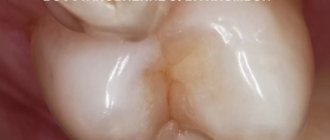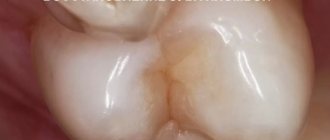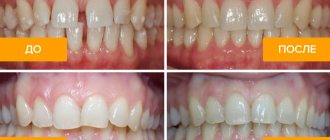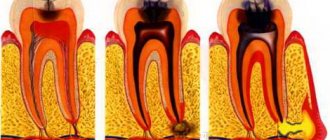Is a refilling necessary if nothing bothers me?
Many patients are surprised when a dentist recommends replacing an old filling with a new one, because they have no pain or other unpleasant symptoms. However, replacement is carried out not only in cases of severe inflammation, but also for preventive purposes, as well as to improve the aesthetics of the dentition.
Like any other material, the filling mass is subject to gradual wear, deformation, and destruction. Hygienic care, oral microorganisms, saliva pH, mechanical, chemical and temperature effects of food over time provoke the appearance of microscopic cracks in the filling. The resulting pores serve as a breeding ground for microbes and the development of dental diseases.
How much does it cost to install a light seal?
In order to most accurately tell you how much it costs to get a light filling, you need to understand what type of filling will be installed, as well as where exactly the treatment will take place. The cost of a light filling in a state clinic starts from 900 rubles. As a rule, this is a medium quality composite material intended for the restoration of chewing teeth. In private dental clinics in Moscow, the price of a light filling starts from 1,500 – 2,000 rubles. Light fillings for front teeth are more expensive: for aesthetic restorations, the price can exceed 3,000 rubles.
How long can a filling last?
The service life of a filling is determined by several factors, the main ones being the following:
- correct installation and size,
- characteristics of the material from which it is made,
- the condition of the abutment tooth, the thickness of its walls,
- features of hygienic care: brush hardness, abrasiveness of pastes, etc.
- the presence or absence of certain habits: for example, high consumption of nuts, seeds, opening corks with teeth,
- the predominance of solid and/or tough foods in the diet, and so on.
As a rule, the minimum service life is 3-5 years, but some materials can last 10 years or more. In fact, it depends more on the condition of the treated tooth itself after a while.
Which filling is right for you?
There are different types of fillings, each of them has its own pros and cons, and to a greater extent, filling is an individual process and requires not only payment for the service, but also a consultation with a dentist.
Which filling is right for you will become clear only after consultation with a dentist. Make an appointment with us and our doctors will advise you on this issue properly! We remind you that our clinic is located on Danube Prospekt, 23 , just 400 meters from the Zvezdnaya metro station (St. Petersburg), in a separate 16-storey building, and also at the address: Polikarpova Alley, 4k1, just 400 meters from the station metro station "Pionerskaya" in a brick 15-story building of a standard design, immediately behind the house from the metro station (the sign of our neighbors "Gym" and "Furniture" can serve as a guide). Dental fillings at YuliSTOM, like all dental services at the European level, are at the most affordable prices.
Why does caries develop under the filling mass?
The development of a carious process under the filling material is often observed due to poor-quality treatment of the tooth cavity during treatment. The remains of the affected tissues serve as a source of infection, which intensifies and covers increasingly larger areas of the dentition unit.
Caries can also form if the filling is carried out in violation of the protocol. An incorrectly applied composition quickly becomes unusable, losing its fixation with the walls of the tooth cavity or collapsing under the influence of the aggressive environment of the oral cavity. Microbes penetrate into the resulting cracks and voids, which “trigger” the destructive process.
Another factor that provokes the development of caries is the natural “aging” of the filling. The appearance of microdamages (and micropores) on it and in it, which is inevitable over time, contributes to the accumulation of pathogenic bacteria, their reproduction, and the occurrence of recurrent disease. Therefore, it is advisable to replace old fillings with new ones after their expiration date.
Why do they put a temporary filling?
In cases where there is a pathological process in the root canals, preliminary treatment with various medicinal compounds is required. In order for the medicine to remain in the canal for the required period, it is secured by installing a temporary filling. It also acts as a protective barrier against germs, bacteria and food debris that can get into the cavity of a diseased tooth.
Main indications for temporary tooth closure:
- Isolation of therapeutic antiseptic pad.
- Inflammation of the pulp (pulpitis). For this, arsenic paste is used to destroy the nerve of the tooth.
- Deep caries with damage to dentin.
- Periodontitis.
- Manufacturing of ceramic permanent inlay.
- The need to reschedule treatment.
Sometimes temporary filling is used for diagnostic purposes. If caries has damaged the deep layers, then it is impossible to find out exactly how damaged the pulp is. Therefore, the doctor must observe the tooth to choose the optimal treatment. The absence of pain indicates the vitality of the tooth, which means there is no need to remove the nerve.
What types of fillings are there?
Today, various materials are used to fill teeth. The most widespread are the following:
- cement: it is cheap, therefore it is actively used in the budget dental field. Fillings made from this material are susceptible to destruction, short-lived (maximum - 1-2 years), when replacing them, doctors often diagnose a carious process,
- amalgam: based on mercury, copper and silver. They are characterized by high strength, but the appearance leaves much to be desired. In addition, mercury is a toxic substance,
- <>photopolymers: the most modern option. They harden in the light, are durable, highly aesthetic and natural in appearance. On average, they last about five years,
- chemically cured composites: the material cures on its own, without exposure to a blue light lamp (but can still be used to speed up the process). A very durable composition, most often applied to chewing areas - premolars and molars. Aesthetics worse than photopolymers,
- glass ionomer cements: differ from classical cements in a large number of advantages, because They last a long time, the price is not too high, they are low allergenic and can be installed for children.
Types of fillings according to materials used
The materials used to make fillings can vary from precious metals to modern polymers. They may differ in their appearance, wear resistance and price.
Cement based
Cement tooth fillings have been around for a very long time. Their use was most common before the advent of various modern materials. This is due to the low cost of the components that make up them.
Other advantages of such fillings include:
- low shrinkage;
- tight fit to the tooth, which prevents the possibility of falling out or the appearance of secondary caries;
- long service life.
As for the disadvantages of these fillings, the main one is the unnatural color of the material, which often differs from the surface of the tooth, as well as the likelihood of its pigmentation under the influence of coffee, food coloring, etc.
Plastic
Plastic fillings are used quite rarely. Most often they are used to close small cavities, and are also used in pediatric dentistry for filling baby teeth. Plastic fillings are often used as temporary fillings in multi-stage treatment. Like the previous option, they are low cost.
Among the disadvantages of such fillings are strong shrinkage of the material and the presence of a porous structure, which can cause secondary caries, since it does not properly protect against bacteria.
Amalgam
Amalgam are tooth fillings made of metal alloys with different compositions. It may contain mercury, tin, gold, etc. One or another option should be chosen depending on personal preferences and the available budget, since some of them are very expensive. A significant disadvantage of such a filling is its unnatural color, which differs significantly from the shade of tooth enamel.
The main advantage of this type of filling is its durability. Amalgam fillings have one of the longest lifespans and are often chosen for placement in posterior teeth.
Ceramics
Ceramic fillings are among the most expensive. Their advantages:
- they have natural shades and are therefore invisible on the teeth;
- do not change color under external influences;
- have a long service life.
The downside is that such fillings must be made separately, so the treatment process always takes place in several stages.
Light-curing composites
One of the most modern and high-quality types of fillings are light-curing composites. They are highly durable and aesthetically pleasing, since the doctor can always choose the most suitable shade that will not differ from the patient’s natural tooth enamel. The main advantage of this material for fillings is that it hardens only under the influence of a special lamp, so the doctor can regulate this process and adjust the shape of the tooth filling before its final hardening.
Glass ionomer cement material
Glass ionomer cement is a material that combines the properties of silicate and polyacrylic systems. Such fillings are used extremely rarely, although they have high adhesion to tooth tissue and other materials. This ensures the durability of the filling and its good fit. However, this material has mild toxic properties, so it is gradually being abandoned in dentistry.
When is a refilling required?
To determine when a filling needs to be replaced, you should contact your dentist. He will conduct a diagnosis, including x-rays, and, if necessary, carry out a replacement.
Indications for refilling are the following conditions:
- pain in a filled tooth,
- crown destruction,
- detection of caries under filling material,
- feeling of an unpleasant taste,
- decreased aesthetics of the restoration,
- expiration of the seal's service life.
The most common situations in which refilling is required are discussed below.
Changing Hue
Yellowness, darkening and other color changes in the filling (and enamel) most often indicate the presence of a destructive process in the tooth. If there is a reddish tint, it means that the previously installed material contains resorcinol - in this case, not only a refilling is required, but also additional cleaning of the canals, as well as an internal bleaching procedure.
Abrasion of the filling mass
Over time, the fillings wear out, which leads to disruption of the distribution of chewing load. As a result, the bite changes, the load on the temporomandibular joint increases, TMJ pathologies develop, and digestive problems arise.
Overhanging filling
If installed incorrectly, the filling material may “hang” over the adjacent tooth or gum. The accumulation of food particles and impaired contact between units of the dentition provoke an inflammatory process in soft tissues, the proliferation of microorganisms and the development of caries, and bleeding gums.
Subsidence of the filling mass
Shrinkage is typical for any materials used for filling. If it occurs along the axis of the tooth, a person’s bite may change, which will lead to problems with the TMJ and digestion. In addition, vertical subsidence provokes the appearance of cracks and even chips in the tooth, since, as the filling contracts, it “pulls” the hard tissues along with it. When subsidence occurs in the horizontal plane, the degree of contact between adjacent units changes, food debris gets stuck in the interdental spaces, the formation of caries and gum inflammation are observed.
Flat filling surface
If, when filling, the dentist did not pay due attention to the chewing surface, but made it flat, disruption of the chewing process will gradually lead to the development of problems with the gastrointestinal tract. Normally, there are cusps and fissures on it, which ensures full contact with the opposite teeth of the other jaw.
Roughness has appeared
The rough surface of the filling indicates the presence of pores and microscopic cracks in it. This means that microbes have already penetrated into it. Often, when the filling material is removed in such cases, caries is revealed underneath it.
Expired service life
Even if the filling was installed more than 10-15 years ago and still holds, it does not mean that it is fulfilling its function. In the vast majority of cases, when refilling such “rarities”, an extensive carious process is determined.
Unaesthetic appearance
Refilling may be required if the previously installed filling stands out in shade from the background of the remaining teeth. Most often, the situation occurs after the whitening procedure. Over the period of operation, old compounds have absorbed various coloring substances, so to restore the aesthetic appearance (especially of the front units), they need to be replaced.
Possible complications
Common problems that may arise after installing a temporary filling include:
- Discomfort or soreness. On the first day, a little pain is normal. But if the pain intensifies, and even more so, soft tissue swelling appears, then consult a doctor earlier than scheduled. This symptom may indicate a possible infection, as well as the spread of the pathological process.
- Strange taste in mouth. May occur if a medicated pad is used. But if the taste is strong and unpleasant, then this means that the seal’s tightness is broken. Reinstallation required.
- Change in enamel color (darkening) or redness of the gums around the tooth. Alarm signal. A medical examination and x-ray are required.
The appearance of any severe discomfort should alert you. If you do not see a doctor on time, you can get complications, including tooth loss.
What to do if the filling falls out
Even if you follow all the dentist's recommendations, the filling may fall out. This mainly happens for two reasons:
- Low quality of the filling material used.
- Doctor's error during installation.
But in most cases, the filling falls out due to the fault of the patient himself. In any case, if a temporary filling falls out, you should definitely contact the doctor who installed it. Walking around with an open cavity in a tooth can cause it to become infected. It is also prohibited to cover it with cotton wool, chewing gum or other improvised materials.
How does the replacement take place?
Many patients are worried: is it painful to change a filling? The procedure is performed under local anesthesia and is therefore absolutely painless.
In general terms, re-sealing occurs as follows:
- anesthesia is administered
- the desired tooth is isolated from the oral cavity with a rubber dam: so that moisture and microorganisms do not enter the treated cavity,
- old filling material and tissues affected by caries (if any) are removed
- the cavity is treated with a special etching solution and dried,
- an insulating or medicinal pad is applied,
- a new filling is applied.
Restoration takes place with mandatory consideration of the anatomical features of the chewing surface.
Indications for filling
Filling is one of the methods of restoring the integrity of a tooth. Reasons for treatment:
- stop inflammation in the mouth;
- caries at the initial, middle stages;
- loss of a previously installed filling;
- channel cleaning;
- restore the integrity of the tooth, including after injury;
- prevent the development of complications;
- prevent tooth loss.
In addition, inflammation in the oral cavity and caries are a powerful factor in reducing immunity. Timely treatment will help prevent infection of other organs, since pathogenic flora is often transferred through the bloodstream.
Caries superficial, medium and deep
How to extend the service life of filling material
How often the filling will have to be changed depends on how correctly it is used. To extend the life of the material, just listen to the following tips:
- don’t skimp on material: very cheap means it won’t last long,
- avoid increased stress on the filling: do not open bottles, avoid excessively hard foods,
- avoid sudden changes in temperature in the oral cavity: do not take too hot or cold food,
- select oral hygiene items and products in accordance with the characteristics of the teeth.
In addition, even in the absence of complaints, you need to regularly visit the dentist for timely detection of pathologies and defects. It is better to spend a few minutes grinding than to have to refill it after some time. Preventative visits will save time and money, and will also keep your nerves and teeth in perfect order.
Rules of care
A temporary “barrier” is less durable than a permanent one. He is able to cope with the chewing load for up to two to three weeks. If you "carry" it, it will collapse or fall out. In this regard, until the dentist replaces it with a permanent one, it is important to follow the following rules:
- Avoid eating too solid foods. Nuts, crackers, seeds, etc. are prohibited.
- Do not use chewing gum or sticky candies.
- Carry out hygienic cleaning twice a day - in the morning and in the evening after meals. Use only a brush with soft bristles.
- Do not use a paste containing abrasive particles during treatment.
- After each meal, hygienically rinse the mouth with warm water.
By keeping these rules in mind, you can significantly reduce the likelihood of destruction of the established composition.
How teeth are filled - stages of treatment
Installation of the seal is carried out in several stages. Although the entire treatment process can take place in one visit to the dentist. Stages of therapy:
- Diagnosis, anesthesia - according to indications.
Establishing diagnosis
- Removal of destroyed tissue, assessment of the condition of the pulp.
Removal of destroyed tissue
- According to indications, opening of the pulp chamber and removal of the dental nerve.
Removal of dental nerve
- Treatment of canals, filling them.
Canal treatment
- When treating extensive pulpitis, it is possible to install medications under a temporary filling.
- After the inflammatory process has stopped, a permanent filling is installed. Polymer materials are used for this. They are introduced into the cavity and harden under the influence of a UV lamp. At the end of the procedure, the filling is polished.
Installation of a permanent filling
No specialized preparation for filling is required. The procedure is carried out either as planned or urgently if pain or tissue swelling develops on the day of visiting the doctor. Before going to the clinic, it is recommended to remove any remaining food from the mouth and brush (as far as possible) your teeth.











